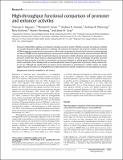| dc.contributor.author | Nguyen, Thomas A. | |
| dc.contributor.author | Jones, Richard D. | |
| dc.contributor.author | Snavely, Andrew R. | |
| dc.contributor.author | Pfenning, Andreas R. | |
| dc.contributor.author | Kirchner, Rory | |
| dc.contributor.author | Hemberg, Martin | |
| dc.contributor.author | Gray, Jesse M. | |
| dc.date.accessioned | 2017-02-16T15:31:38Z | |
| dc.date.available | 2017-02-16T15:31:38Z | |
| dc.date.issued | 2016-06 | |
| dc.date.submitted | 2016-01 | |
| dc.identifier.issn | 1088-9051 | |
| dc.identifier.issn | 1549-5469 | |
| dc.identifier.uri | http://hdl.handle.net/1721.1/106954 | |
| dc.description.abstract | Promoters initiate RNA synthesis, and enhancers stimulate promoter activity. Whether promoter and enhancer activities are encoded distinctly in DNA sequences is unknown. We measured the enhancer and promoter activities of thousands of DNA fragments transduced into mouse neurons. We focused on genomic loci bound by the neuronal activity-regulated coactivator CREBBP, and we measured enhancer and promoter activities both before and after neuronal activation. We find that the same sequences typically encode both enhancer and promoter activities. However, gene promoters generate more promoter activity than distal enhancers, despite generating similar enhancer activity. Surprisingly, the greater promoter activity of gene promoters is not due to conventional core promoter elements or splicing signals. Instead, we find that particular transcription factor binding motifs are intrinsically biased toward the generation of promoter activity, whereas others are not. Although the specific biases we observe may be dependent on experimental or cellular context, our results suggest that gene promoters are distinguished from distal enhancers by specific complements of transcriptional activators. | en_US |
| dc.description.sponsorship | National Institute of Mental Health (U.S.) (Grant R01 MH101528-01) | en_US |
| dc.language.iso | en_US | |
| dc.publisher | Cold Spring Harbor Laboratory Press | en_US |
| dc.relation.isversionof | http://dx.doi.org/10.1101/gr.204834.116 | en_US |
| dc.rights | Creative Commons Attribution-NonCommercial 4.0 International | en_US |
| dc.rights.uri | http://creativecommons.org/licenses/by-nc/4.0/ | en_US |
| dc.source | Cold Spring Harbor Laboratory Press | en_US |
| dc.title | High-throughput functional comparison of promoter and enhancer activities | en_US |
| dc.type | Article | en_US |
| dc.identifier.citation | Nguyen, Thomas A. et al. “High-Throughput Functional Comparison of Promoter and Enhancer Activities.” Genome Research 26.8 (2016): 1023–1033. | en_US |
| dc.contributor.department | Massachusetts Institute of Technology. Computer Science and Artificial Intelligence Laboratory | en_US |
| dc.contributor.mitauthor | Pfenning, Andreas R. | |
| dc.relation.journal | Genome Research | en_US |
| dc.eprint.version | Final published version | en_US |
| dc.type.uri | http://purl.org/eprint/type/JournalArticle | en_US |
| eprint.status | http://purl.org/eprint/status/PeerReviewed | en_US |
| dspace.orderedauthors | Nguyen, Thomas A.; Jones, Richard D.; Snavely, Andrew R.; Pfenning, Andreas R.; Kirchner, Rory; Hemberg, Martin; Gray, Jesse M. | en_US |
| dspace.embargo.terms | N | en_US |
| dc.identifier.orcid | https://orcid.org/0000-0002-3447-9801 | |
| mit.license | PUBLISHER_CC | en_US |
| mit.metadata.status | Complete | |
